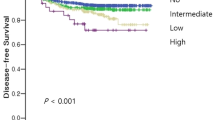Abstract
PURPOSE: Lymph node metastasis is an important indicator of tumor stage and prognosis in pT1 and pT2 colorectal adenocarcinomas. Lymphovascular invasion is an established risk factor of lymph node metastasis, whereas budding at the invasive front of tumors is also reported to correlate with lymph node metastasis. We examined whether the coexistence of lymphovascular invasion and budding provides any better information than lymphovascular invasion alone in the prediction of lymph node metastasis of pT1 or pT2 well-differentiated colorectal adenocarcinomas. METHODS: Surgically resected specimens of 101 pT1 or pT2 well-differentiated colorectal adenocarcinomas were studied. Using sections stained with hematoxylin-eosin, we examined lymphovascular invasion and budding according to Morodomi’s definition. RESULTS: Lymphovascular invasion was present in 39 lesions (38 percent), whereas budding was found in 42 lesions (41 percent). Budding was more frequently detected in pT2 tumors than in pT1 tumors. The presence of budding significantly correlated with lymphovascular invasion. Sensitivity, specificity, positive predictive value, and negative predictive value of lymphovascular invasion alone for lymph node metastasis were 79, 76, 34, and 96 percent, respectively, whereas those of the combination of lymphovascular invasion and budding (either lymphovascular invasion or budding) were 93, 52, 24, and 98 percent, respectively. CONCLUSION: Because the risk of lymph node metastasis in pT1 or pT2 well-differentiated colorectal adenocarcinomas having neither lymph node metastasis nor budding is very low, budding in combination with lymphovascular invasion seems to be a simple and inexpensive pathologic marker in predicting lymph node metastasis. Therefore, the presence or absence of budding should be examined in the routine pathologic diagnosis of pT1 or pT2 well-differentiated colorectal adenocarcinomas.
Similar content being viewed by others
References
BD Minsky C Mies TA Rich A Recht (1989) ArticleTitleLymphatic vessel invasion is an independent prognostic factor for survival in colorectal cancer Int J Radiat Oncol Biol Phys 17 311–318
C Compton CM Fenoglio-Preiser N Pettigrew LP Fleding (2000) ArticleTitleAmerican Joint Committee on Cancer prognostic factors consensus conference colorectal working group Cancer 88 1739–1757
MJ Krasuna L Flancbaum RP Cody S Shneibaum G Ben Ari (1988) ArticleTitleVascular and neural invasion in colorectal carcinoma Cancer 61 1018–1023
K Hase C Shatney D Johnson M Trollope M Vierra (1993) ArticleTitlePrognostic value of tumor “budding” in patients with colorectal cancer Dis Colon Rectum 36 627–635
K Hase CH Shatney H Mochizuki et al. (1995) ArticleTitleLong-term results of curative resection of “minimally invasive” colorectal cancer Dis Colon Rectum 38 19–26
T Morodomi H Isomoto K Shirouzu K Kakegawa K Irie M Morimatsu (1989) ArticleTitleAn index for estimating the probability of lymph node metastasis in rectal cancers Cancer 63 539–543
T Imai (1954) ArticleTitleThe growth of human carcinoma Fukuoka Igaku Zasshi 45 72–102
RK Phillips R Hittinger L Blesovsky LP Fielding (1984) ArticleTitleLarge bowel cancer Br J Surg 71 604–610
S Coverlizza M Risio A Ferrari (1989) ArticleTitleColorectal adenomas containing invasive carcinoma Cancer 64 1937–1947
JR Jass SB Love JM Northover (1987) ArticleTitleA new prognostic classification of rectal cancer Lancet 2 1303–1306
M Ono M Sakamoto Y Ino et al. (1996) ArticleTitleCancer cell morphology at the invasive front and expression of cell adhesion-related carbohydrate in the primary lesion of patients with colorectal carcinoma with liver metastasis Cancer 78 1179–1186
JR Jass WS Atkins J Cuzick et al. (1986) ArticleTitleThe grading of rectal cancer Histopathology 10 437–459
M Conese F Blasi (1995) ArticleTitleThe urokinase/urokinase-receptor system and invasion Baillieres Clin Haematol 8 365–389
M Martin P Pujuguet F Martin (1996) ArticleTitleRole of stromal myofibroblasts infiltrating colon in tumor invasion Pathol Res Pract 192 712–717
I Carr P Watson NM Pettigrew (1989) ArticleTitleMechanisms of invasion and lymphatic penetration in human colorectal cancer Clin Exp Metastasis 7 507–516
CE Dukes HJ Bussey (1958) ArticleTitleThe spread of rectal cancer and its effect on prognosis Br J Cancer 12 309–320
Author information
Authors and Affiliations
About this article
Cite this article
Okuyama, T., Oya, M. & Ishikawa, H. Budding as a Risk Factor for Lymph Node Metastasis in pT1 or pT2 Well-Differentiated Colorectal Adenocarcinoma. Dis Colon Rectum 45, 628–634 (2002). https://doi.org/10.1007/s10350-004-6259-0
Issue Date:
DOI: https://doi.org/10.1007/s10350-004-6259-0




